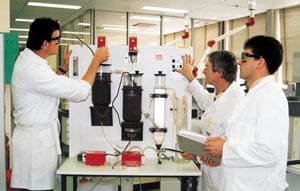
Companies must innovate in order to keep ahead of their competitors. If an organisation wants to create a business strategy that keeps it at the forefront of innovation, it must develop ways of making that strategy work.
Being innovative does not just involve using the expertise of market researchers, scientists and product developers to create new products. It also involves using the capabilities of everyone within an organisation to generate the processes that help the new product to reach the market quickly and efficiently. It is after all people who innovate and not companies, and they need the right environment which provides both support and encouragement.
So why are some companies more successful innovators than others? One theory about culture contrasts defender and prospector organisations. The defender culture resists change and favours strategies that provide security. This is usually supported by a bureaucratic style of management. On the other hand, a prospector organisation thrives on change and innovation. It differentiates its products in a creative and flexible working regime.
This case study focuses upon one such prospector organisation – Procter & Gamble. It shows how building an innovative culture has enabled the company to meet wider business objectives and maintain its competitive advantage in a rapidly changing market place.
AG Lafley, the President and Chief Executive of Procter & Gamble, outlined the importance of innovation to the company. He would like to develop a business in which ‘big ideas attract the capital and talent they need’ and points to the innovation equation:

Globalisation and the explosion of technology make it more important than ever for Procter & Gamble to ‘embrace its future’. It has recently been re-structured in order to accelerate the creation of new products, speed up decision-making, set goals and stretch targets for developing the business and provide rewards for those who do so.
A key element in building an organisation that is innovative and competitively further ahead than others is to set clear goals and objectives that help to provide the direction for the organisation. Within P&G this is reflected through a series of principles which underpin how employees work and help to provide a purposeful base for their activities.
The goals are as follows:
- It respects all individuals – the uniqueness of each employee is valued and their contributions listened to the interests of the company and the individual are inseparable -both employees and the company work for mutual benefit.
- It is strategically focused in its work – product development helps the company to sustain a competitive advantage over other organisations.
- Innovation is the cornerstone of its success – the company is proactive in leading the field of product development.
- It is externally focused – the company listens to consumers and monitors markets.
- It values personal mastery – the skills of employees are nurtured.
- It seeks to be the best – the company is not complacent about product and market development.
- Mutual interdependency is a way of life – the company depends upon employees, markets and consumers.

The ‘human resource’ focus within Procter & Gamble is linked to organisational vitality driven by every department. In removing the barriers that hold people back, it energises people to use their expertise, integrity, drive and hunger to contribute to new product development and serve consumers better. This often involves using their creativity and powers of innovation to go beyond accepted ideas to generate new ways of getting better results. As a result it is accepted that the creative talents and drive of more than 100,000 people within the organisation will determine where the organisation will make a difference in its global markets.
People are at the sharp end of innovation, not companies. Procter & Gamble’s human resource department has the responsibility for the development and growth of people towards higher levels of skill, competency, creativity and fulfilment, in a way that supports each individual. It sets out to foster individual improvement in the workplace, with the opportunity for enhanced work satisfaction as each employee is able to make fuller use of his or her skills and abilities. Human resource development seeks to ensure that the right people with the right attitude and skills support the Procter & Gamble culture.
Within Procter & Gamble the focus is upon involving people across the business either to develop their ideas or become involved in working together to make ideas happen. At the heart of this culture is the innovative use of connections, centred upon understanding consumers, the energy directed towards innovation, supported by research and development processes.
There are many inventors, but the ones who are successful are those who bring their inventions into the marketplace where consumers can benefit from them. An invention is a seed of innovation, but it remains a seed unless it is commercialised successfully. The birth of a new product is thus a combination of the skills of people involved in its research and development, combined with the abilities of others who develop processes that launch the product effectively within carefully selected market segments.
Organisations that are designed for innovation have three characteristics:
- They make it easy for innovation to flow throughout the enterprise.
- They make it possible to learn quickly from consumers.
- They make it possible to develop ideas profitably time and time again.

Procter & Gamble currently holds more than 25,000 patents world-wide, and is launching more products than at any time in its history. Investment into research and development has provided the business with the unique opportunity to transfer new technological and scientific breakthroughs across a range of product developments in a way that makes sure that it works. At a time of unprecedented change in the marketplace, unleashing innovations at a faster speed than the competition will lead to growth and the further development of the business.
Every time you see an innovative new product on a supermarket shelf, remember that it started as a good idea in someone’s head. Some products may be completely new, whilst others may be extensions, ongoing developments or improvements of existing products. A new product may be one which replaces or extends an old produc;opens up a new market; or broadens an existing market. Ideas for new product development (NPD), whilst all having a clear benefit for consumers, may come from several different sources including:
- ideas from salespeople, who are close to customers such as retailers and are in a strong position to understand their needs
- ‘blue sky’ laboratory work in new areas, that creates new product ideas and concepts that have never before been explored
- combining two technologies or joining products together to develop a single new product, such as shampoo and conditioner
- transferring technologies from one series of products and processes across to other product ranges and to other processes
- extensions of existing products which provide goods in better and more convenient forms for the consumer
- improving existing concepts, so that all products are constantly developing to meet increasingly sophisticated consumer requirements.
Procter & Gamble has innovated by introducing proactive development across the company. This involves making connections between countries, across product ranges, through different markets and by transferring technologies used from one product range to another. A new product may simply be created from a minor change involving an extension, or the development of a totally new product concept.
One key factor is the ability of its people to learn from each other by transferring the expertise or best practice in product innovation, developed in one country through to another. This enables different parts of the group to combine technologies and experiences and is known as technology transfer. Each business unit is involved with product development. Each unit’s research and development is linked to its markets as well as the activities of the other units.
As a result innovation takes place wherever consumer needs can be met by ideas generated by staff. In developing the business in a way that integrates progress with the social development and environmental concerns of a fast-changing society sustainable development is a key element. Reducing environmental impact and improving manufacturing and product efficiency through better approaches to innovation can both improve products and also help to develop business opportunities.
Osteoscan
Research undertaken by Dr David Francis within Procter & Gamble focusing upon releasing calcium ions laid the groundwork for many other product opportunities, including improvements to a toothpaste called Crest. It was his vision in making the leap from one area of chemistry to another which led to the discovery of a new class of compounds – bisphosphonates!
The first medical product to result from this innovation was Procter & Gamble’s Osteoscan which was used as a bone scanning agent. But it was research that P&G scientists were doing within the laundry products area which prompted the original research. They were looking for ways to prevent calcium from re-depositing on clothes during washing. This work, combined with Dr Francis’ knowledge of the chemistry of teeth led to the discovery of a drug, called Didronel, which provides treatment for people suffering from bone disease (resulting from hip replacement or spinal cord injury).
Swiffer
The British Allergy Foundation recently awarded its seal of approval to the cleaning system called Swiffer, launched by Procter & Gamble. Innovation is about listening to consumers. Sometimes when a business develops products there are unexpected benefits as there were for users of Swiffer. Allergies occur when a person’s immune system becomes supersensitive causing it to over-react to otherwise harmless substances called allergens.
Whereas traditional dusting methods can simply spread dust around, the Swiffer system was designed to capture dust, which includes the common indoor allergens, such as dust mite, cat and dog allergens. Swiffer has been proved, in independent testing, to remove indoor allergens more effectively than traditional household cleaning methods. In tests, Swiffer picked up over 93% of cat and dog allergens, compared with less than 16% for a standard broom, and less than 28% for a standard mop.
Flash antibacterial wipes
Another recent transfer of technology within P&G has been certified by the Royal Institute of Public Health and Hygiene. Investment in research and development created the concept of baby wipes. The concept was so successful that it was realised that the products could be used elsewhere and this led to the launch of Flash antibacterial wipes which kill germs for up to 12 hours. Consumers are increasingly discerning and require wipes to clean and provide protection both outside and inside the home. Available in both a tub and refill value pack, the disposable wipes can be used around the home or in other areas such as the car. The concept and technology behind the product was originally used in baby wipes.
Procter & Gamble has built an organisation with an innovative culture. Everybody can contribute to new product development either through research and development or through their focus, energy and commitment to their role.
This approach to innovation is not new. For example, Procter & Gamble’s dedication to innovation led to the development of Flash, a revolutionary brand for its time. Since its launch many hundreds of innovations now enable it to cater for many more situations within the household much more efficiently. Similarly P&G created the disposable nappy business by introducing Pampers.
In a fast-changing world an innovative culture helps an organisation constantly move forward. Having an innovative culture has actively helped Procter & Gamble develop and transfer technologies and bring new products to market. Creating innovations that give people products which make their lives easier and better is what creates a competitive advantage for P&G. And is what has helped P&G become the successful global business it is today.
